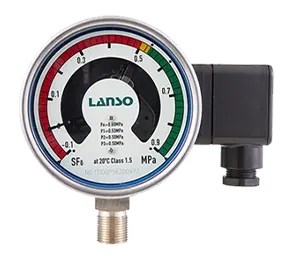With the continuous development of the power system, SF6 circuit breakers play a crucial role as an important high-voltage electrical equipment in the grid. SF6 Gas Density Monitor, as an essential component of SF6 circuit breakers, the setting of its alarm and interlock signals is particularly important. In the electrical system, maintaining the proper density of SF6 gas is critical to ensuring the normal operation of SF6 circuit breakers.
Setting the Alarm Signal of SF6 Gas Density Monitor
In SF6 circuit breakers, setting the alarm signal is essential for timely detection of gas pressure abnormalities. This signal often manifests as a pressure alarm signal, also known as a gas replenishment alarm signal. The set value is usually lower than the rated working pressure by 5%~10%, ensuring that the alarm can be triggered promptly when the SF6 gas density decreases to a certain level. This early warning mechanism helps prevent potential issues and ensures the reliability of SF6 circuit breakers.
The Density Monitor monitors the density of SF6 gas, reflecting real-time changes in gas conditions. SF6 gas has a certain density value in a fixed container, which is the mass per unit volume under specific conditions. The Density Monitor accurately measures this parameter, providing a critical basis for the normal operation of circuit breakers. During operation, if the density of SF6 gas decreases and the pressure drops accordingly, the Density Monitor will trigger an alarm signal based on the set value, reminding operators to take timely measures to ensure equipment safety.
Setting the Interlock Signal of SF6 Gas Density Monitor
In addition to the alarm signal, the Density Monitor in SF6 circuit breakers also plays a critical role in setting the interlock signal. The setting of the interlock signal is to prevent closing and opening operations in the event of insufficient SF6 gas density, avoiding potential safety hazards. Typically, the set value of the interlock signal is 8%~10% lower than the rated working pressure, ensuring that closing and opening operations are automatically prohibited when the SF6 gas density reaches a certain level.
The change in SF6 gas density is affected by temperature, but under normal operating conditions, its density remains relatively stable. To ensure the stability of insulation and arc extinguishing performance, national standards require SF6 circuit breakers to be equipped with pressure gauges or SF6 gas density monitors and density relays. The density relay not only monitors but also plays a crucial role in control and protection.
In modern electrical systems, the stable operation of SF6 circuit breakers relies on the accurate monitoring and timely feedback of SF6 gas density monitors. By setting parameters for alarm and interlock signals reasonably, potential issues can be effectively prevented, ensuring that SF6 circuit breakers can operate efficiently even in complex and unexpected situations, maintaining the safety and stability of the power system.







